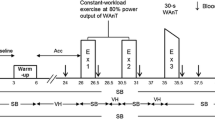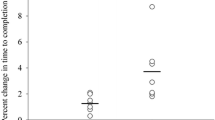Abstract
The aim of the present study was to investigate whether the changes in breathing pattern that frequently occur towards the end of exhaustive exercise (i.e., increased breathing frequency, f b, with or without decreased tidal volume) may be caused by the respiratory work itself rather than by leg muscle work. Eight healthy, trained subjects performed the following three sessions in random order: (A) two sequential cycling endurance tests at 78% peak O2 consumption (V˙O2peak) to exhaustion (A1, A2); (B) isolated, isocapnic hyperpnea (B1) at a minute ventilation (V˙ E) and an exercise duration similar to that attained during a preliminary cycling endurance test at 78% V˙O2peak, followed by a cycling endurance test at 78% V˙O2peak (B2); (C) isolated, isocapnic hyperpnea (C1) at a V˙ E at least 20% higher than that of the preliminary cycling test and the same exercise duration as the preliminary cycling test, followed by a cycling endurance test at 78% V˙O2peak (C2). Neither of the two isocapnic hyperventilation tasks (B1 or C1) affected either the breathing pattern or the endurance times of the subsequent cycling tests. Only cycling test A2 was significantly shorter [mean (SD) 26.5 (8.3) min] than tests A1 [41.0 (9.0) min], B2 [41.9 (6.0) min], and C2 [42.0 (7.5) min]. In addition, compared to test A1, only the breathing pattern of test A2 was significantly different [i.e., V˙ E: +10.5 (7.6) l min−1, and f b: +12.1 (8.5) breaths min−1], in contrast to the breathing patterns of cycling tests B2 [V˙ E: −2.5 (6.2) l min−1, f b: +0.2 (3.6) breaths min−1] and C2 [V˙ E: −3.0 (7.0) l min−1, f b: +0.6 (6.1) breaths min−1]. In summary, these results suggest that the changes in breathing pattern that occur towards the end of an exhaustive exercise test are a result of changes in the leg muscles rather than in the respiratory muscles themselves.
Similar content being viewed by others
Author information
Authors and Affiliations
Additional information
Accepted: 7 October 1999
Rights and permissions
About this article
Cite this article
Spengler, C., Knöpfli-Lenzin, C., Birchler, K. et al. Breathing pattern and exercise endurance time after exhausting cycling or breathing. Eur J Appl Physiol 81, 368–374 (2000). https://doi.org/10.1007/s004210050056
Issue Date:
DOI: https://doi.org/10.1007/s004210050056




